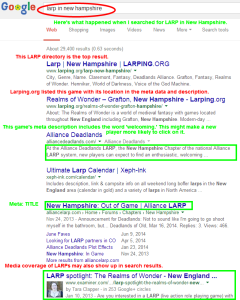Marketing your LARP (live action role playing game) online requires a fair amount of time. When done well initially, it requires an hour or two of maintenance each week. For this reason, you may choose to elect one or more staff members to manage your game’s website, social media, and other online presence. These tips may also prove useful to convention and general event organizers. Here are 10 tips for marketing your game effectively online.
1. Include clearly visible contact information – Your location is one of the most important elements of your website – and the number one feature most LARP websites lack. Your location should be listed on every page. Additionally, you should have readily visible contact information on each page, such as an email address. This is the number one mistake most people make when presenting or speaking about their LARP online: they fail to mention location. Geography is a crucial element of a person’s likelihood to attend – never assume someone knows your location.
2. Metadata – This is the text on the backend that Google and other search engines use to determine the relevancy of your site to whatever queries are made. This should include the name of your game, a location, and a critical keyword such as LARP. If someone is searching for “Whatevergenre LARP in Yourcity,” are they going to find you?
The metadata includes your website name, the posts of your pages or blog entries, and the meta description. Make sure to keep your metas brief, as Google only displays so much on searches. You can learn more about metadata here.
3. Build your website properly – Most LARP websites feature the basics – what kind of costuming or weaponry you need to start playing, etc. However, heading to a new LARP can be extremely intimidating, even for the most experienced LARPer. Some details about the location (where to park, how early to arrive, facilities available) can make your game seem as welcoming as it really is.
If you’re planning to start a game and haven’t already, you should create your website as soon as you have a solid concept. This is important because Google uses multiple factors to rank your site in its search engines, such as the age of your site.
4. Increase visibility and credibility – Make sure you get your LARP listed on some reputable sources, such as LARPing.org’s LARP list. You should do your best to leverage the internet to socialize with other LARPers. If your geographic location includes a competitive LARP culture, try reaching out to local game organizers outside of your game’s genre.
5. Consider posting in groups with permission – Make sure you check group rules on any Facebook groups (or online forums) you post to about your game. If Facebook groups do not have rules regarding promotion posted, simply message the admin and ask permission to post about your game. (They usually say ‘yes.’)
6. Get the most out of visual media – If you have promotional photos, high-quality logos or graphics, or videos, they should have a home on your website – but don’t forget to also toss them onto your social media sites. Facebook and Twitter have converted to a more visual timeline format favoring photos and videos. Take advantage of it!
7. Know your audience – Which social media networks does your ideal audience use? Tumblr is one of the most underleveraged social media platforms when it comes to marketing LARPs, mainly because some LARP organizers are older than the average tumblr user (or LARPer). Tumblr is a great way to get feedback and make connections with others.
8. Keep it current – List current events and locations and make sure they’re visible on as much of your website as possible. Always post event reminders on your social media platforms. This not only helps inform your players but helps your search ranking. Google loves websites that are constant updating their content. Plus, if you post the state next to your location listings, you’ll rank better when people search for “LARP in ZZ,” where ZZ is your state abbreviation.
Blogs or even character journals are a great way to keep your site current. Plus, your players may be happy to provide you with content (just make sure you edit and approve it first to ensure a curated online presence).
9. Manage your social media – Use a social media calendar (a free Google calendar works well) to manage your social media postings. When do you want to post and on which platform? You may wish to get a Hootsuite account to manage your social media accounts for the game. If you aren’t a social media maven or king of the hashtags, don’t worry – your social media knowledge will grow intuitively as you use it. Plus, social media best practices evolve as rapidly as the social media sites, which are always in flux.
10. Always respond to public feedback – What do you do if someone posts a negative comment to our about you on one of your public forums or a social media site? You should see it as an opportunity. Respond to the criticism quickly and professionally, even if it is just to alert the poster that s/he will receive a response soon. By letting others know that you handle criticism well, you are showing them that you have the capacity to run a game well and treat others with respect.
Examples of websites that employ most of these best practices:
- Seventh Kingdom IGE – Frequent front page updates, posts current event and location information, answers questions/feedback readily and professionally. Uses logo and graphics consistently to create strong branding.
- College of Wizardry – Simple and visually stunning layout; sells players on the concept of the game and the reputation of the organizer without overloading them with rules. Presents the basic info easily.
- Travelers of Ki’Mara – The tone of the website conveys the genre of the LARP; high-quality graphics, simple navigation.
- FaeGlen LARP – Keeps it current by posting event information and highlighting players of the month. Friendly tone conveyed throughout site.
Additional quick tips:
- Watermark your images and event photos – they’ll likely get re-posted if they’re good.
- Provide resources for press on your website.
- Provide an image and/or HTML code and encourage players to link to your site. This increases visibility and encourages your search engine ranking.
- Use natural, organic SEO every time you talk about your game.
Regardless of your marketing strategies, your most valuable marketing tool is always going to be word of mouth, especially if you are running a campaign LARP. Additionally, presenting yourself (the game owner, staff members) in the community provides you the opportunity to not only promote your game, but affect change and learn about new techniques in a rapidly evolving hobby.
Please feel free to leave additional tips or comments below.
Tara M. Clapper (Tara the Bard) has over a decade of experience in online content writing and digital marketing, including the marketing of a live action role playing game and articles about LARP and related topics. Visit TaraWrites.com to learn about how Tara can help you get noticed in a crowded digital landscape.






